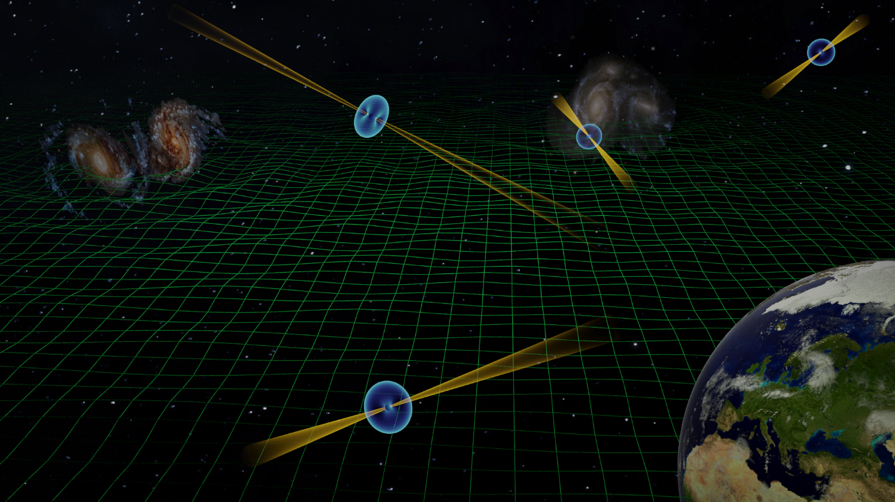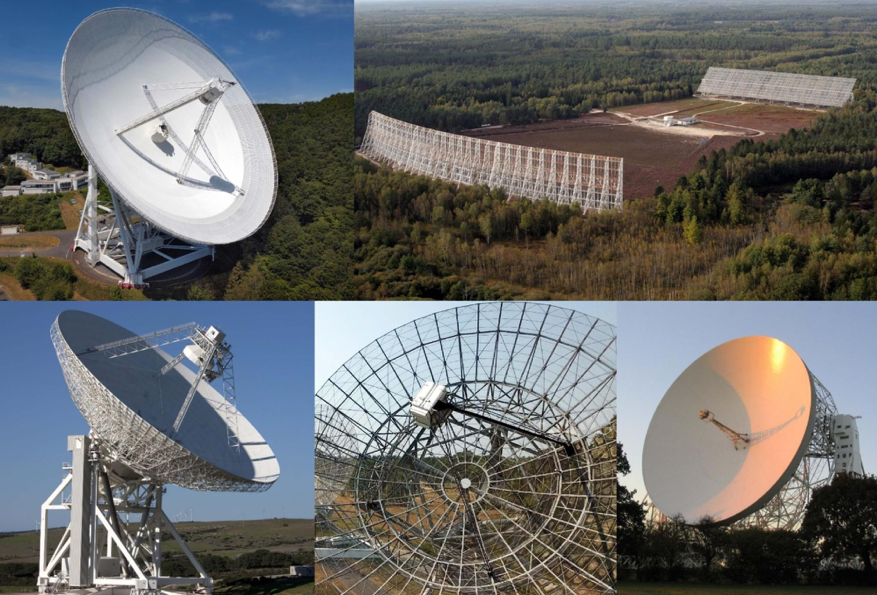The European Pulsar Timing Array (EPTA) is a scientific collaboration bringing together teams of astronomers around the largest European radio telescopes, as well as groups specialized in data analysis and modelling of gravitational wave (GW) signals. It has published a detailed analysis of a candidate signal for the since-long sought gravitational wave background (GWB) due to in-spiraling supermassive black-hole binaries. Although a detection cannot be claimed yet, this represents another significant step in the effort to finally unveil GWs at very low frequencies, of order one billionth of a Hertz. In fact, the candidate signal has emerged from an unprecedented detailed analysis and using two independent methodologies. Moreover, the signal shares strong similarities with those found from the analyses of other teams. The results were made possible thanks to the data collected over 24 years with five large-aperture radio telescopes in Europe (Figure 2).
Radiation beams from the pulsars’ magnetic poles circle around their rotational axes, and we observe them as pulses when they pass our line of sight, like the light of a distant lighthouse. Pulsar timing arrays (PTAs) are networks of very stably rotating pulsars, used as galactic-scale GW detectors. In particular, they are sensitive to very low frequency GWs in the billionth-of-a-Hertz regime. This will extend the GW observing window from the high frequencies (hundreds of Hertz) currently observed by the ground-based detectors LIGO/Virgo/KAGRA. While those detectors probe short lasting collisions of stellar-mass black holes and neutron stars, PTAs can probe GWs such as those emitted by systems of slowly in-spiraling supermassive black-hole binaries hosted at the centres of galaxies. The addition of the GWs released from a cosmic population of these binaries forms a GWB.
Radio astronomers can measure small fluctuations in the arrival times of the pulsars’ radio signal at Earth, caused by the spacetime deformation due to a passing-by very low frequency GW. In practice, these deformations manifest as sources of a very low frequency noise in the series of the observed times of arrival of the pulses, a noise which is shared by all the pulsars of a PTA. However, the amplitude of this noise is incredibly tiny (estimated to be tens to a couple hundreds of a billionth of a second) and in principle many other effects could impart that to any given pulsar in the PTA.
To validate the results, multiple independent codes with different statistical frameworks were then used to mitigate alternate sources of noise and search for the GWB. Importantly, two independent end-to-end procedures were used in the analysis for cross-consistency. Additionally, three independent methods were used to account for possible systematics in the Solar-system planetary parameters used in the models predicting the pulse arrival times, a prime candidate for false-positive GW signals.
The EPTA analysis with both procedures found a clear candidate signal for a GWB and its spectral properties (i.e. how the amplitude of the observed noise varies with its frequency) remain within theoretical expectations for the noise attributable to a GWB.
Dr. Nicolas Caballero, researcher at the Kavli Institute for Astronomy and Astrophysics in Beijing and co-lead author explains: “The EPTA first found indications for this signal in their previously published data set in 2015, but as the results had larger statistical uncertainties, they were only strictly discussed as upper limits. Our new data now clearly confirm the presence of this signal, making it a candidate for a GWB “.
Einstein’s General Relativity predicts a very specific relation among the spacetime deformations experienced by the radio signals coming from pulsars located in different directions in the sky. Scientists call that as the spatial correlation of the signal, or Hellings and Downs curve. Its detection will uniquely identify the observed noise as due to a GWB. Dr. Siyuan Chen, researcher at the LPC2E, CNRS in Orleans, co-lead author of the study, notes “At the moment, the statistical uncertainties in our measurements do not allow us yet to identify the presence of spatial correlation expected for the gravitational-wave background signal. For further confirmation we need to include more pulsar data into the analysis, however the current results are very encouraging “.
The EPTA is a founding member of the International Pulsar Timing Array (IPTA). As analyses of independent data performed by the other IPTA partners (i.e. the NANOGrav and the PPTA experiments) also indicated similar common signals, it has become vital to apply multiple analysis algorithms to increase confidence in a possible future GWB detection. The IPTA members are working together, drawing conclusions from comparing their data and analyses to better prepare for the next steps.
Dr. Nicolas Caballero, concludes: “The detection of a GWB from a population of supermassive black hole binaries or from another cosmic source will give unique insights into the cosmological models, by imposing strong quantitative constraints to the galaxy assembling process, which led from the early times to the Universe as we are seeing it today. We are therefore intensifying our efforts with more pulsar data, and correspondingly more cross-checks applied to the growing data sets. It is a very complicated work and we want to eliminate any room for mistakes.”

Figure 1: Artistic impression of the EPTA experiment. A coordinated network of European radio telescopes observed an array of pulsars distributed across the sky. The measured variation in the arrival time of the emitted pulses on Earth allows astronomers to study tiny variations in spacetime. These variations, called gravitational waves, still propagate the Universe from a distant past, when galaxies merged and the supermassive black holes in their centre orbited each other with a period of a few years to produce them.
Link for high-res image: https://drive.google.com/file/d/1RyIn6Ahx_WtAQGBF3sMRwOBWfeN2BivP/view?usp=sharing

Figure 2: The Five Major European Radio Telescopes from left top to right bottom: the 100-m Radio Telescope near Effelsberg in Germany, the 94-m Nançay Decimetric Radio Telescope in France, the 76-m Lovell Telescope in Cheshire/United Kingdom,the 16 antennas of the Westerbork Synthesis Radio Telescope in the Netherlands and the 64-m Sardinia Radio Telescope at Pranu Sanguni, Italy. In the observing mode of the Large European Array for Pulsars (LEAP), the EPTA telescopes are tied together to synthesize a fully steerable 200-m dish to greatly enhance the sensitivity of the EPTA towards gravitational waves.
Link for high-res image: https://cloud.mpifr-bonn.mpg.de/index.php/s/JTMJz45CXs7pJc5
The authors of the paper are: S. Chen, R. N. Caballero, Y. J. Guo, A. Chalumeau, K. Liu, G. Shaifullah, K. J. Lee, S. Babak, G. Desvignes, A. Parthasarathy, H. Hu, E. van der Wateren, J. Antoniadis, A.-S. Bak Nielsen, C. G. Bassa, A. Berthereau, M. Burgay, D. J. Champion, I. Cognard, M. Falxa, R. D. Ferdman, P. C. C. Freire, J. R. Gair, E. Graikou, L. Guillemot, J. Jang, G. H. Janssen, R. Karuppusamy, M. J. Keith, M. Kramer, X. J. Liu, A. G. Lyne, R. A. Main, J. W. McKee, M. B. Mickaliger, B. B. P. Perera, D. Perrodin, A. Petiteau, N. K. Porayko, A. Possenti, A. Samajdar, S. A. Sanidas, A. Sesana, L. Speri, B. W. Stappers, G. Theureau, C. Tiburzi, A. Vecchio, J. P. W. Verbiest, J. Wang, L. Wang and H. Xu.
PKU authors are members of the Pulsar Group at Kavli Institute for Astronomy and Astrophysics. They are corresponding author R. N. Caballero (postdoc), and co-authors K. J. Lee (faculty) and H. Xu (Ph.D student). Corresponding author S. Chen will be joining Prof. Lee’s pulsar group later this year and Y.J. Guo is a recent Ph.D. graduate from PKU.
Further information and links:
Original Paper: https://academic.oup.com/mnras/article/508/4/4970/6410749
(permanent DOI link: https://doi.org/10.1093/mnras/stab2833)
ArXiv Link: https://arxiv.org/abs/2110.13184
European Pulsar Timing Array (EPTA):
http://www.epta.eu.org/
Scientific summary of the paper’s result by the EPTA:
http://www.epta.eu.org/aom/EPTA_6PSR_CRS_SCIENTIFIC_SUMMARY.pdf
Kavli Institute for Astronomy and Astrophysics at Peking University
http://kiaa.pku.edu.cn/
Effelsberg Radio Telescope – MPIfR
https://www.mpifr-bonn.mpg.de/en/effelsberg
Nançay Radio Telescope – Paris Observatory
https://www.obs-nancay.fr/radiotelescope-decimetrique/
The Lovell Telescope - Jodrell Bank
https://www.jodrellbank.net/visit/whats-here/lovell-telescope/
The Westerbork Radio Telescope – ASTRON
https://www.astron.nl/telescopes/wsrt-apertif/
The Sardinia Radio Telescope - INAF
http://www.srt.inaf.it/
Local Contacts:
Prof. Kejia Lee
Kavli Institute for Astronomy and Astrophysics, Peking University
Fon: +86 10 62766380
E-mail:kjlee@pku.edu.cn
Dr. Nicolas Caballero
Kavli Institute for Astronomy and Astrophysics, Peking University
E-mail: caballero.astro@gmail.com